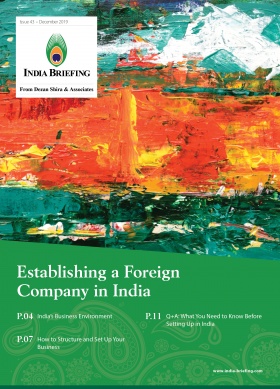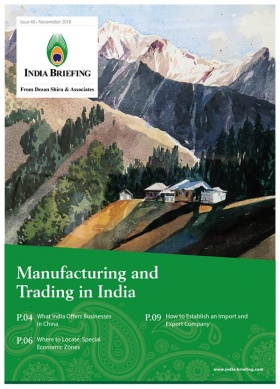Impact of China’s Disrupted Supply Chain on India amid COVID-19
- COVID-19 has disrupted China’s supply chain, impacting economies around the world, including India.
- Some of India’s most prominently affected industries are automobile, pharmaceuticals, electronics, and chemicals.
- According to UNCTAD, India is on the list of the top 15 economies affected by slowdown in production in China.
With China being a major supplier of raw materials and components to the world, the global supply chain has received more than its fair share of shocks due to the COVID-19 (coronavirus) outbreak. Even though most factories and manufacturing units in China have by now resumed their operations, many have yet to run at capacity due to multiple challenges, including a smaller returning workforce or tentative restrictions in regional movements. This could lead to delayed timelines for delivery of products and components.
The disruption in China has impacted the Indian manufacturing sector greatly, especially the automobile, pharmaceuticals, chemicals, and electronics industries as well as micro, small, and medium enterprises (MSMEs).
According to a report published by the United Nations Conference on Trade and Development (UNCTAD), India is among the top 15 economies most affected as slowdown of manufacturing in China disrupts world trade due to COVID-19 outbreak. The trade impact for India is estimated to be around US$348 million, with the chemical sector expected to take a big hit – of about US$129 million. Meanwhile, Moody’s, an American business and financial services company, has cut the economic growth forecast for India to 5.3 percent for 2020 from an earlier estimate of 6.6 percent.
However, companies and industries continue to be optimistic. For instance, auto manufacturer BMW recently stated they do not anticipate any stress on their India operations till June. Maruti Suzuki also had a similar response about their India operations. One reason for this apparent preparedness would be normal inventory stockpiling due to China’s annual Lunar New Year holidays anyway slowing production in January-February.
Here we breakdown the supply chain disruptions in India by highlighting the impact on specific industries.
1. Automobile
Like most industries, the automobile industry also maintained an inventory due to the Lunar New Year holiday. While some companies seem confident about their operations in India, others have started to worry about missed delivery timelines.
According to the Society of Indian Automobile Manufacturers (SIAM), unavailability of certain auto parts is likely to hamper the production of passenger vehicles, three-wheelers, two-wheelers, and certain electric vehicles in India in the coming months. SIAM says it has reached out to the government with certain recommendations on behalf of the Indian auto industry.
Chinese firms supply between 10 and 30 percent of auto parts to various carmakers in India. These include braking and steering systems, engine parts, and illumination systems. India’s own auto parts industry says it will benefit from China’s supply chain blockages but how far this local capacity exists on the ground is yet to be tested.
It was reported in the media earlier this week that automakers are paying high prices to fly down components from China and South Korea on chartered flights.
While most of the auto companies based in India appear set for the next three months, if the supply chain concerns remain unresolved, it will amount to a significant cost that could carry over to the consumer or will simply slow down production. Given this potential scenario, industry will reach out to the government for assistance, such as in the form of tariff relaxations and tax breaks.
2. Pharmaceuticals
According to a report from the Confederation of Indian Industry (CII), Indian pharmaceutical companies are “running close to exhausting their supply of raw materials.”
Keeping in mind concerns over supply shortages, the Indian government already announced restrictions on the export of 26 active pharmaceutical ingredients (APIs) and formulations.
Some of the restricted drugs and ingredients include paracetamol, metronidazole, neomycin, tinidazole, ornidazol, acyclovir, progesterone, chloramphenicol, erythromycin salts, clindamycin salts, and range of vitamins such as B1, B6, and B12.
Indian drug makers source about 70 percent of their ingredients from Chinese factories (all of whom have been impacted by the COVID-19 outbreak leading to shutdowns). Like many other industries, the pharma industry too had procured ingredients in advance on account of planning for the usual Lunar New Year slowdown, and the Indian government has been assured there are enough supplies to last until June 2020.
Yet, there are conflicting reports coming out of the Indian pharmaceutical industry in the financial press. In a March 4 report by The Guardian, industry experts from India said that supplies are running low and are expected to be finished in a month or so. Further, they claimed that if the factories in China do not reopen soon, there will be an impact on drug prices and Indian plants. However, in a March 10 report by The Economic Times, some pharmaceutical lobby groups asked the government to lift restrictions on APIs, claiming there will be no shortages of these formulations during the outbreak.
These conflicting reports hint that something is amiss – it could be that industry lobbies and pharmaceutical companies do not want to showcase their reliance on China’s supply chain on the one hand but at the same time cannot afford the blockage on exports. Either way, the Indian government will not be taking any chances with regards to the availability of medications in the local market – even the appearance of a shortage would result in public panic.
3. Micro, small, and medium enterprises (MSMEs)
According to the national traders’ body, Confederation of All India Traders (CAIT), which represents 70 million traders in India – majority of them MSMEs – Chinese goods worth INR 30 billion (US$406.2 million) are lying with intermediaries across India as the impact of COVID-19 keeps traders away from the market.
Even though the stock was imported from China at least 45 to 60 days before the COVID-19 outbreak, the retailers and consumers seem to be uninterested in the products. This could also be contributed to the fact that there is already a slowdown impacting domestic demand.
Further, during the Indian festival Holi, inventory worth INR 5 billion (US$68.63 million) from China was lying with importers across the country. As COVID-19 cases increased in India, it was expected that crowds will stay away from celebrations, hence it impacted the sales. The estimated loss for small businesses is yet to be calculated.
With the supply chain in some state of shock and traders cancelling their buying trips to China and other coronavirus affected countries in Southeast Asia, the outbreak is expected to impact the business performance of MSMEs in the near term.
4. Textile
While other industries in India grapple with the aftermath of the COVID-19 outbreak, reports say that India’s textile industry has received enquiries from US, Europe, and Russia on whether it could match the shortfall in supply due to China’s factories having shutdown for an extended period.
With global buyers looking for alternative markets, India could resuscitate its textile manufacturing industry.
Meanwhile, if the COVID-19 outbreak continues, garment manufacturers in India might have to look at local sourcing that could increase their costs by three to five percent. In that event, businesses will look to the government for assurance, like their other Asian counterparts.
India Briefing is produced by Dezan Shira & Associates. The firm assists foreign investors throughout Asia from offices across the world, including in Delhi and Mumbai. Readers may write to india@dezshira.com for business support in India.
- Previous Article Procedures for US Businesses to Establish a Liaison Office in India
- Next Article The Expanding Role of Technology in India’s HR Industry







